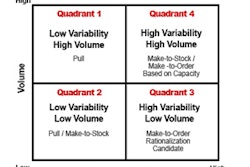Although there is some functionality overlap, the differences between warehouse management systems (WMS) and warehouse control systems (WCS) can be significant. But until they are fully comprehended, companies that rely on the day-to-day movement of product in and out of a distribution center or warehouse can find themselves at a distinct disadvantage.
"A lot of companies probably don't know the difference in a WMS and a WCS system," says Jerry List, vice president of QC Software in Cincinnati. "To put it simply, the WMS plans a weekly activity forecast, based on such factors as statistics, trends and so forth. And a WCS acts like a floor supervisor, working in real time to get the job done by the most effective means.
"For instance," continues List, "a WMS can tell the system it's going to need five of SKU A and five of SKU B, hours in advance, but by the time it acts, other considerations may have come in to play and all of a sudden you have a logjam on a conveyor." A WCS can prevent that problem from happening by working in real time and adapting to the situation on the spot. "It can make a 'last-minute decision' based on current activity and operational status," says List.
Warehouse management systems began to flourish in the 1980s with the introduction of mini-computers. According to Kevin Tedford of KT Consulting in Marion, Ohio, who has worked with warehouse management systems for the past 20 years, companies knew when the time was right to implement a WMS into their distribution center operation.
"Businesses saw the need for a warehouse management system when they started hitting certain 'pain points'," explains Tedford. "This usually happened when they saw the costs of delivery rising, labor costs on the increase and a need to control inventory and keep track of what their people were doing. It was the moment they first began to realize they had no control."
According to Tedford, what the warehouse management system did was return the control to the distribution center supervisor. "The greatest advantage was it brought back inventory control and accuracy," he says. "And brought it back to a super-high level, so much so that companies could now exceed their customers' highest expectations, performing tasks in hours that at one time may have taken days or even weeks."
"Better, Faster, Cheaper"
With the turn of the century and the increase in the need to move more products faster in a shorter amount of time — and do it with fewer workers — technology began to accelerate.
The simple act of walking up and down a warehouse aisle picking products from a paper order was replaced by high-tech pick-to-light and pick-to-voice technology. The pace quickened and the products increased, and so did the need for better order verification and order fulfillment.
According to Jerry List: "Suddenly, there was a 'better, faster, cheaper' mentality prevalent in the warehouse. And the old-school WMS mentality was being challenged. As warehouse management systems began to take on more responsibilities, a void was created which warehouse control systems nicely filled, especially as systems became faster and real-time demands were established."
Explains Jerry Lovell, senior electrical project engineer for Lakeland, Fla.-based material handling systems integrator TriFactor, "Over the past 10 years, distribution centers saw an increased need for improved warehouse communications, from the WMS to the WCS to the conveyor to the customer."
Adds Lovell: "Companies are now able to see the status of their material handling system in real time, with all information up-to-date. Today they can make a hard decision right on the spot, where 10 years ago they more or less had to guess. They know right away if something is wrong, and they can react with a faster response time. I once had a company executive tell me that having a WCS system in his warehouse lets him sleep at night."
Jerry List agrees. "A warehouse control system enables you to utilize new technology, which allows greater flexibility on the plant floor," he says "It's an integrating tool that ties everything together. Think of equipment like conveyors and picking technology as building blocks. The WCS is the mortar between the blocks that holds everything together."
Adds List, "The perfect candidate for a WCS is the company that utilizes a lot of material handling devices and needs to put a lot of decision points in their system and be able to balance them all in an efficient manner."
List points out that another key advantage to the WCS is location. "Sometimes in the case of multiple warehouses, the warehouse management system is not physically located in the warehouse," he says. "But even if there's a network-wide problem, the warehouse control systems, being situated in the warehouse, can keep the operation up and running."
Knowing When You Need a WCS
Not every operation needs or requires a warehouse control system, particularly those that hand-pick from paper and pallets, or those have a minimal number of product lines and/or SKUs. But according to a white paper produced by List and QC Software, there are some very real telltale signs that there could be a WCS in your company's future:
To put the difference between WMS and WCS in simple terms, WMS is a planning system, WCS is an execution system. The WMS collects a vast amount of information, such as inventory data, customer orders and historical data, and then processes it in a non-real-time mode, mapping out a workload plan for what needs to be done on the warehouse floor on a day-to-day basis. But it's the warehouse control system that has final control over the large amount of information being placed by the WMS and reacts to "actual" events on the warehouse floor.
Think of it as a symphony orchestra. The WMS is the composer, creating a musical score that feature reeds, woodwinds and strings, together making beautiful sounds. But anyone who has ever heard the dreadful noise an orchestra makes when it is tuning up knows that it needs the conductor to pull it all together. In this case, that conductor is the warehouse control system, making sure the material handling "instruments" (conveyors, sorters, pick-to-light, etc.) perform in perfect harmony and efficiency.
According to Jerry List, a company may want to explore the possibility of adding a WCS if they have the following characteristics:
TriFactor's Jerry Lovell agrees. He feels warehouses must keep up with the technology being offered. "WMS and WCS is an important piece of the technology puzzle," says Lovell. "There's a consistency factor knowing that technology can perform the same tasks, over and over, eliminating the possibility of human error. Technology is reliability. WMS and WCS give you the peace of mind of knowing that your system is using proven technology. If your competition has it and you don't, then you are at a definite competitive disadvantage."
"A lot of companies probably don't know the difference in a WMS and a WCS system," says Jerry List, vice president of QC Software in Cincinnati. "To put it simply, the WMS plans a weekly activity forecast, based on such factors as statistics, trends and so forth. And a WCS acts like a floor supervisor, working in real time to get the job done by the most effective means.
"For instance," continues List, "a WMS can tell the system it's going to need five of SKU A and five of SKU B, hours in advance, but by the time it acts, other considerations may have come in to play and all of a sudden you have a logjam on a conveyor." A WCS can prevent that problem from happening by working in real time and adapting to the situation on the spot. "It can make a 'last-minute decision' based on current activity and operational status," says List.
Warehouse management systems began to flourish in the 1980s with the introduction of mini-computers. According to Kevin Tedford of KT Consulting in Marion, Ohio, who has worked with warehouse management systems for the past 20 years, companies knew when the time was right to implement a WMS into their distribution center operation.
"Businesses saw the need for a warehouse management system when they started hitting certain 'pain points'," explains Tedford. "This usually happened when they saw the costs of delivery rising, labor costs on the increase and a need to control inventory and keep track of what their people were doing. It was the moment they first began to realize they had no control."
According to Tedford, what the warehouse management system did was return the control to the distribution center supervisor. "The greatest advantage was it brought back inventory control and accuracy," he says. "And brought it back to a super-high level, so much so that companies could now exceed their customers' highest expectations, performing tasks in hours that at one time may have taken days or even weeks."
"Better, Faster, Cheaper"
With the turn of the century and the increase in the need to move more products faster in a shorter amount of time — and do it with fewer workers — technology began to accelerate.
The simple act of walking up and down a warehouse aisle picking products from a paper order was replaced by high-tech pick-to-light and pick-to-voice technology. The pace quickened and the products increased, and so did the need for better order verification and order fulfillment.
According to Jerry List: "Suddenly, there was a 'better, faster, cheaper' mentality prevalent in the warehouse. And the old-school WMS mentality was being challenged. As warehouse management systems began to take on more responsibilities, a void was created which warehouse control systems nicely filled, especially as systems became faster and real-time demands were established."
Explains Jerry Lovell, senior electrical project engineer for Lakeland, Fla.-based material handling systems integrator TriFactor, "Over the past 10 years, distribution centers saw an increased need for improved warehouse communications, from the WMS to the WCS to the conveyor to the customer."
Adds Lovell: "Companies are now able to see the status of their material handling system in real time, with all information up-to-date. Today they can make a hard decision right on the spot, where 10 years ago they more or less had to guess. They know right away if something is wrong, and they can react with a faster response time. I once had a company executive tell me that having a WCS system in his warehouse lets him sleep at night."
Jerry List agrees. "A warehouse control system enables you to utilize new technology, which allows greater flexibility on the plant floor," he says "It's an integrating tool that ties everything together. Think of equipment like conveyors and picking technology as building blocks. The WCS is the mortar between the blocks that holds everything together."
Adds List, "The perfect candidate for a WCS is the company that utilizes a lot of material handling devices and needs to put a lot of decision points in their system and be able to balance them all in an efficient manner."
List points out that another key advantage to the WCS is location. "Sometimes in the case of multiple warehouses, the warehouse management system is not physically located in the warehouse," he says. "But even if there's a network-wide problem, the warehouse control systems, being situated in the warehouse, can keep the operation up and running."
Knowing When You Need a WCS
Not every operation needs or requires a warehouse control system, particularly those that hand-pick from paper and pallets, or those have a minimal number of product lines and/or SKUs. But according to a white paper produced by List and QC Software, there are some very real telltale signs that there could be a WCS in your company's future:
- Your current system is inefficient and takes too long to get a product out the door.
- You're growing fast and can't handle the volume, especially during peak time.
- Your conveyor system has cartons everywhere, but going nowhere.
- You're creating back orders, even though the product is in stock.
- You're shipping products to the wrong place.
- It's getting too expensive to keep modifying your WMS system.
To put the difference between WMS and WCS in simple terms, WMS is a planning system, WCS is an execution system. The WMS collects a vast amount of information, such as inventory data, customer orders and historical data, and then processes it in a non-real-time mode, mapping out a workload plan for what needs to be done on the warehouse floor on a day-to-day basis. But it's the warehouse control system that has final control over the large amount of information being placed by the WMS and reacts to "actual" events on the warehouse floor.
Think of it as a symphony orchestra. The WMS is the composer, creating a musical score that feature reeds, woodwinds and strings, together making beautiful sounds. But anyone who has ever heard the dreadful noise an orchestra makes when it is tuning up knows that it needs the conductor to pull it all together. In this case, that conductor is the warehouse control system, making sure the material handling "instruments" (conveyors, sorters, pick-to-light, etc.) perform in perfect harmony and efficiency.
According to Jerry List, a company may want to explore the possibility of adding a WCS if they have the following characteristics:
- More than $50 million in sales.
- A warehouse larger than 100,000 square feet.
- A conveyor system with multiple sortation points.
- An average of four SKUs per order.
- Greater than 1,000 orders per day.
TriFactor's Jerry Lovell agrees. He feels warehouses must keep up with the technology being offered. "WMS and WCS is an important piece of the technology puzzle," says Lovell. "There's a consistency factor knowing that technology can perform the same tasks, over and over, eliminating the possibility of human error. Technology is reliability. WMS and WCS give you the peace of mind of knowing that your system is using proven technology. If your competition has it and you don't, then you are at a definite competitive disadvantage."














